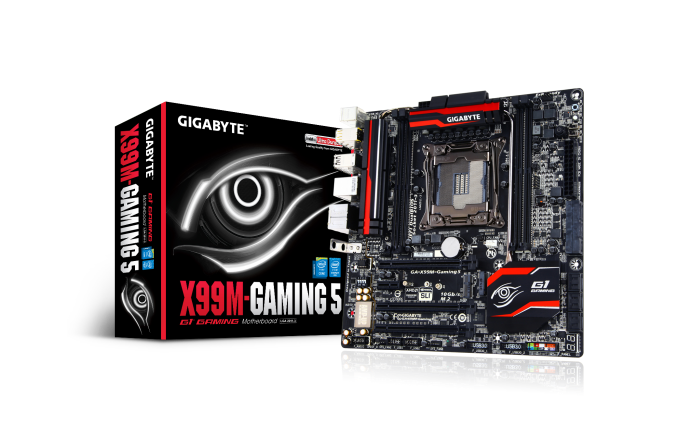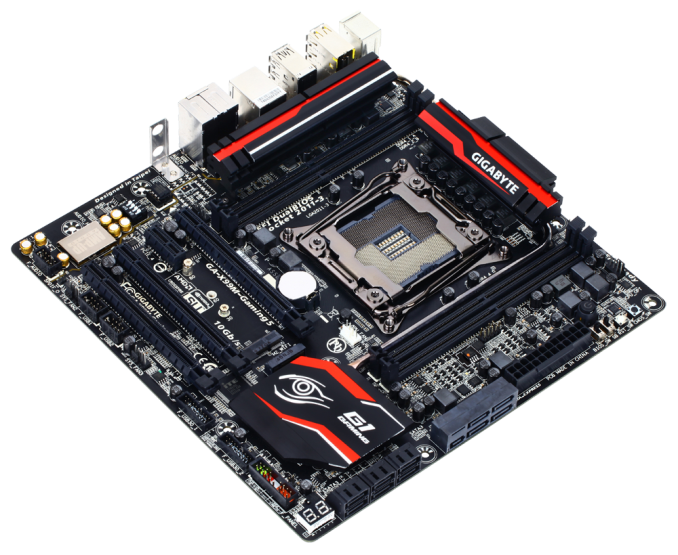GIGABYTE Launches X99M-Gaming 5: Micro-ATX for Haswell-E
by Ian Cutress on November 19, 2014 3:31 AM EST
One noted trend in computing is the desire for more compute in a smaller space. Imagine mixing High Performance Computing with Small Form Factors, if such a thing could be possible without tons of heat or extreme fan noise/cooling. Haswell-E is the peak of multithreaded throughput on the consumer platform, and the choices for small systems based on this CPU line are limited to custom system integrators or micro-ATX motherboards for home builds. At present there are three micro-ATX X99 motherboards on the market, and GIGABYTE becomes the forth by entering the fray with the X99M-Gaming 5.
The X99M-Gaming 5 matches the current generation gaming motherboards from GIGABYTE with its G1.Gaming styling, and unlike other motherboards in this segment uses the CPU PCIe lanes (with a 40 lane CPU) in an x16/x16/x8 arrangement rather than x16/x16 with an additional PCIe 2.0 x4 from the chipset. This means that users with single slot GPUs or PCIe co-processors can use three devices with direct bandwidth to the CPU. Users with an i7-5820K, with 28 PCIe 3.0 lanes, will have access to an x16/x8/x4 arrangement.
GIGABYTE’s custom additions to the chipset begin with their upgraded Realtek ALC1150 audio solution with upgradeable OP-AMPs as well as gold plated audio connectors. Quad USB DAC-UP provides a cleaner power to four of the rear panel USB ports, and the rear IO shield bundled takes advantage of GIGABYTE’s Ambient LED system that we covered at X99 launch.
Networking comes via a Qualcomm Atheros Killer network port and M.2 x1 slot for a WiFi M.2 module which can route the antenna to the back panel - users will have to purchase this separately, or GIGABYTE might make a WiFi edition if demand is sufficient. The X99M-Gaming 5 will support both M.2 x2 and SATA Express, with all ten SATA 6 Gbps ports from the chipset being used. The power delivery also continues GIGABYTE’s design with International Rectifier PowIRStage ICs and server level chokes.
As this is an announcement from GIGABYTE’s headquarters in Taiwan, we are awaiting information via the US offices for North America pricing. The current micro-ATX X99 motherboards on the market currently retail for $235, $250 and $260, so one might suggest that this is also the target.
Source: GIGABYTE
Update 11/20: This motherboard will have an MSRP of $270.












31 Comments
View All Comments
ShieTar - Wednesday, November 19, 2014 - link
I would personally assume that many if not most workstation buyers will be looking for 8 slots for RAM.And two Dual-Slot GPUs, assuming that your small enclosure starts where the board ends, might be quiet starved of fresh air supply.
Go ATX, give them an additional slot of space in between, and you should get much less noise all for the price of the about ~3 inch of office space.
ddriver - Wednesday, November 19, 2014 - link
"I would personally assume that many if not most workstation buyers will be looking for 8 slots for RAM."Not really, 32 gigs of ram is ample for a workstation. More ram is needed for servers.
As for cooling, I already run a uATX workstation, water cooled, 2x 240x120 rads on both ends of the chassis. Runs quite cool, even with considerable overclocking.
dgingeri - Wednesday, November 19, 2014 - link
Exactly what I was thinking. It's like the old x79 Alienware Area 51, where they used microATX. It was an annoying design with too many restrictions, and no airflow for dual video card setups, and they've done the same thing to the new x99 version, but with some strange "Triad case" design. It still only takes two video cards, but at least they left some space between them this time.X99 is for lots of I/O for three or four video cards, or at least two video cards with some airflow space for them. To put it in microATX and say it is for gaming is just asinine. This is NOT a gaming board. Gaming doesn't make use of the extra cores, and that is the only reason to use this board.
Perhaps it could be used for workstation type work where the extra cores would be of some use, but even there, you'd have to have very specific uses with the barest number of cards. Professional dual GPU work couldn't be done with this board. There's not enough space between the cards for proper airflow. They'd be constantly thermally throttling down.
crimsonson - Wednesday, November 19, 2014 - link
X99 allows you to use 6 or 8 core without resorting to Xeon chipset. You can build an video/photo/After Effects computer with X99 and a 1 fast GPU using mATX. Not sure why you assume it has to be at least 2 GPUs. Not all work needs a workstation with dedicated GPUs for compute or render.ShieTar - Wednesday, November 19, 2014 - link
Sure, but on average, how often do you pack your workstation into the back of your moms car and have her drive you to a many Video/Photo/After Effects LAN-Party? I just don't see what you really gain when building a workstation on µ-ATX instead of ATX. Sure its possible to use this board, but that's not the exact point.And with Photo and Video Resolutions still increasing, it seems like you might be interested in another 4 RAM slots in a year or three.
DCide - Wednesday, November 19, 2014 - link
If you do live video production this form factor is fantastic. To answer your question, every week. Every week I'm packing up two low-profile X99 powerhouses and taking them somewhere. When I had less power I was significantly limited in what I could do.I used the ASRock board because it was available at launch time. This has 4 regular slots vs. only 3 on the ASRock, but the ASRock has 2 good NICs on-board.
SirKnobsworth - Wednesday, November 19, 2014 - link
Is there any functional or cost difference between X99 and the Xeon chipsets?dgingeri - Wednesday, November 19, 2014 - link
The C612 chipset (the Xeon version of the X99) is exactly the same chip, however, firmware in the C612 allows for the use of Registered and ECC memory (something that has nothing to do with the chipset) above the features of the X99.Registered memory comes in a lot larger sizes than unbuffered memory. A Xeon in an X99 board would only be able to address 128GB of memory, while a Xeon in a C612 board can address 512GB of memory.
ECC also corrects or prevents many memory errors that might pop up. Many of the unexplainable errors or crashes you experience are likely memory errors that ECC would prevent. It makes for a far more stable system.
Ktracho - Thursday, November 20, 2014 - link
According to Gigabyte's website, this board supports use of registered DIMMs, just not the ECC functionality, so it doesn't look like it's seriously crippled in terms of how much memory you can install.Antronman - Sunday, November 30, 2014 - link
Not quite true.X99 still supports ECC.
The C612 chipset is really something only for servers that need over 128GBs of RAM (as aforementioned), and dual CPUs, as C612 supports dual CPUs.